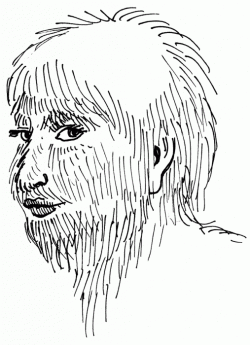Hirsute: Abras Syndrome kinda grows on you
Q. Only about 50 cases of Ambras Syndrome have been reported since the Middle Ages. How does this dramatic hereditary condition manifest itself?–W.M. Jack
A. Men or women grow luxuriant hair all over their face, including the forehead and nose, says Lewis Held Jr. in Quirks in Human Anatomy. A few such people were displayed as curiosities at carnivals in the 1800s under stage names such as the Jo-Jon the Dog-faced Boy and the Lion-faced Man.
In 1868, Charles Darwin described a famous family with this trait: "At the Burmese Court was a man 30 years old with his whole body except hands and feet covered with straight silky hair, which on the shoulders and spine was five inches in length. He had a daughter born with hair in her ears, soon extending over her body. Of her two children, one, a boy 14 months old, had hair growing out of his ears, with a beard and mustache."
Hair growth has also occurred on the neck, the elbows or the palms and soles. Though Ambras Syndrome appears an evolutionary throwback, it cannot be, since apes don't have furry noses, nor do any primates have fur on the palms or soles.
"Because there is no rhyme or reason to these assorted spots,” Held writes, “it's hard to know what to make of them."
Q. If the moon can pull the mighty oceans, and if your body is mostly water, then why shouldn't the moon create tides within you as well? –M. Phelps
A. In our educated society, not one person in a thousand could explain this if their lives depended on it, says Bob Berman in Secrets of the Night Sky.
The problem is the confusion between gravitational and tidal effects: Our planet orbits the sun, not the moon, so the sun has the stronger pull on us. Yet the ocean tides primarily follow the movements of the moon; this is because gravity falls off rapidly with increasing distance, meaning the moon's pull on the side of the Earth facing it is stronger than its pull on the other side, 8,000 miles farther away. This difference is not what produces the tidal effect: it is the tidal effect.
The sun's much greater distance means the difference between its pull on the two sides of Earth is less extreme. The oceans, being interconnected and fluid, respond to the moon's differential pull with a daily rise and fall of about three feet worldwide, with many local variations.
People, on the other hand, average only five to six feet in length, so the moon's pull on anyone's entire body is even and identical. You'd have to grow thousands of miles tall before tides would resonate within you.
"At your present stature, your bodily fluids are no more inclined to migrate from their customary positions than tea in a cup tries to climb up the sides when the moon passes overhead," Berman says.
Q. Just how many species of dinosaurs were there?–M. Crichton
A. Pinning down an exact number is elusive, partly because mistakes have been made during classification, says paleontologist Peter Dodson of the University of Pennsylvania in ScienceIllustrated.Com magazine. For example, scientists recently concluded that a dino they had called "torosaurus" is actually the adult form of triceratops.
To date, researchers have identified approximately 650 extinct species, with about 140 discovered in China, now surpassing the U.S. Using previous rates of discovery, Dodson and Swarthmore College paleo-statistician Steve Wang have estimated that nearly 1,850 species of dinosaurs roamed the Earth at some point. They believe that this number will continue to rise for another century but that "by the start of the 22nd century, 90% of all discoverable species will have been unearthed and new finds will plateau."
~
Send Strange questions to brothers Bill and Rich at [email protected]
